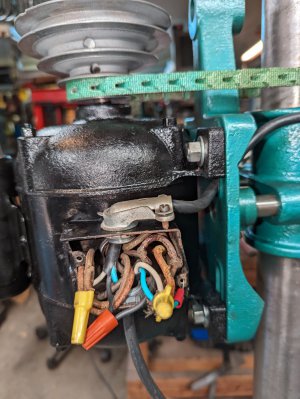- Joined
- Oct 5, 2010
- Messages
- 1,042
I am finishing up restoration of a Walker Turner 900 drill press. It has the original 1/2 hp 120 vac motor, which I checked prior to starting the project. As you can see from the pictures, everything is hooked up and I started to do a run-in to check everything out. The motor will run for nearly a minute and then will trip the breaker 
The motor is under minimum load. Mechanically everything is running smoothly. I do notice that the cord feels a little warm, but other than that, there is no blue smoke and there is no burning smell. It just appears that it is using too many amps.
Warning, I am electrically challenged, but I do have a VOM and an amp meter.
Any suggestions as to what the problem may be and how to fix it? I do have other motors, but I would like to use the Original motor if possible.
TIA
Randy
The motor is under minimum load. Mechanically everything is running smoothly. I do notice that the cord feels a little warm, but other than that, there is no blue smoke and there is no burning smell. It just appears that it is using too many amps.
Warning, I am electrically challenged, but I do have a VOM and an amp meter.
Any suggestions as to what the problem may be and how to fix it? I do have other motors, but I would like to use the Original motor if possible.
TIA
Randy





 It was the centrifugal switch. Getting it apart was no picknick. Since it had been together for 78 years, it was reluctant to come apart. It took a lot of judicious hammer blows to get it to separate
It was the centrifugal switch. Getting it apart was no picknick. Since it had been together for 78 years, it was reluctant to come apart. It took a lot of judicious hammer blows to get it to separate 